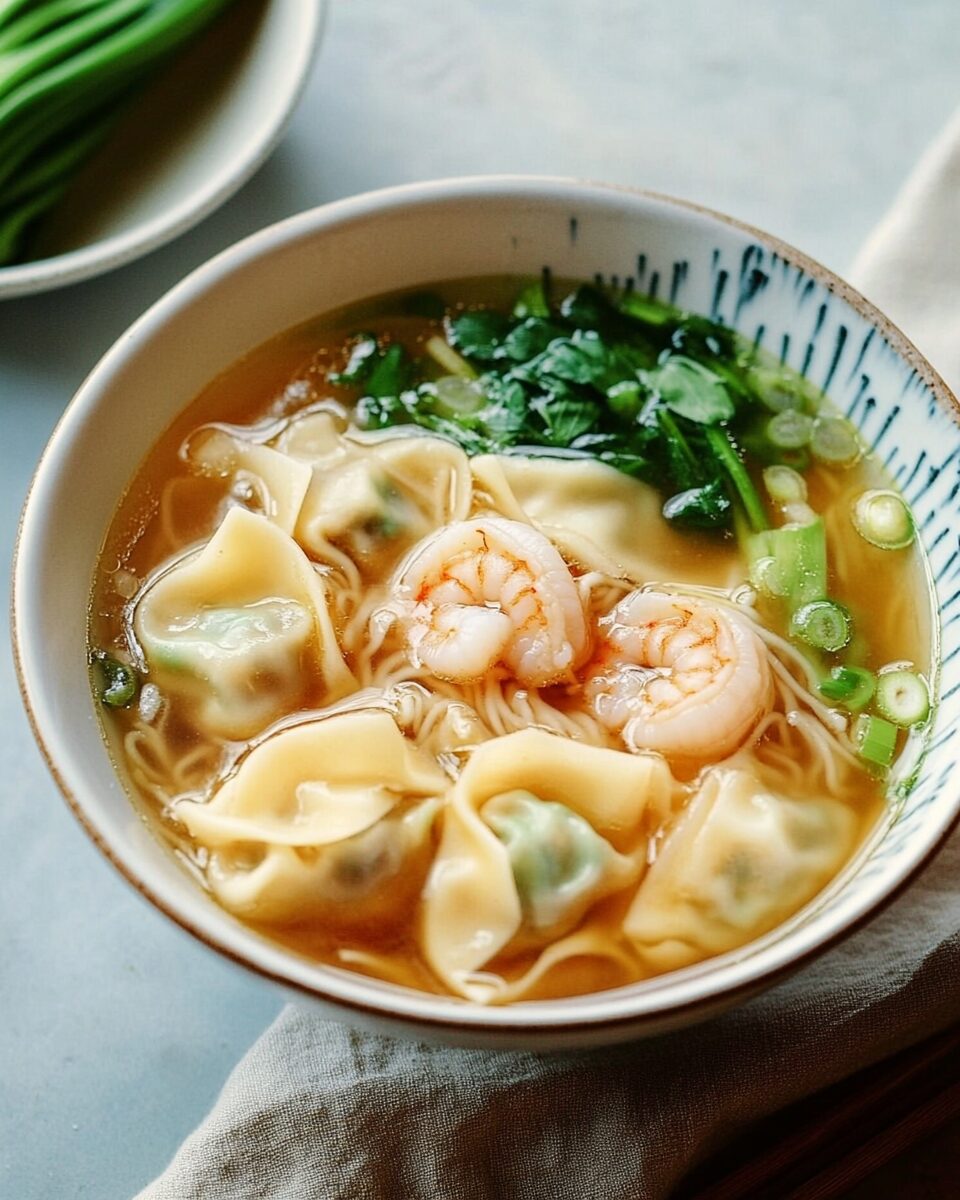The delicate balance of flavors in this Cantonese Wonton Noodle Soup offers a heartwarming taste of traditional Hong Kong cuisine. With juicy pork and shrimp-filled wontons, springy egg noodles, and a fragrant clear broth, every component is carefully crafted to create a soul-satisfying bowl of comfort. This dish is a staple in many Cantonese households and a beloved street food classic. Making the wontons by hand may seem intricate, but the process is both rewarding and surprisingly simple. The rich broth acts as the perfect backdrop for the chewy noodles and succulent dumplings, while fresh greens provide a bright contrast. Whether you’re recreating a taste of home or exploring new flavors, this noodle soup is a timeless treasure.
Full Recipe:
Ingredients:
-
30 wonton wrappers
-
1/2 pound ground pork
-
1/2 pound shrimp, peeled, deveined, and chopped
-
2 tablespoons soy sauce
-
1 tablespoon Shaoxing wine
-
1 tablespoon sesame oil
-
1/2 teaspoon white pepper
-
1 tablespoon finely chopped scallions
-
1 teaspoon grated ginger
-
4 cups chicken stock
-
2 cups water
-
1 tablespoon light soy sauce (for soup base)
-
1/2 teaspoon salt
-
4 portions egg noodles
-
Chopped scallions, for garnish
-
Choi sum or bok choy, for serving
Directions:
-
In a bowl, mix the ground pork, chopped shrimp, soy sauce, Shaoxing wine, sesame oil, white pepper, scallions, and ginger.
-
Place about 1 teaspoon of filling in the center of each wonton wrapper. Fold and seal with water to form a triangle, then bring the two edges together and seal.
-
In a large pot, bring chicken stock and water to a boil. Season with light soy sauce and salt.
-
Drop in wontons in batches and boil for about 4-5 minutes or until they float and are cooked through.
-
In another pot, cook egg noodles according to package instructions. Rinse under cold water and then briefly reheat in hot water.
-
Blanch the choi sum or bok choy.
-
Divide noodles into bowls, add cooked wontons, pour over hot broth, and top with vegetables and chopped scallions.
Prep Time: 30 minutes | Cooking Time: 20 minutes | Total Time: 50 minutes
Kcal: 430 kcal | Servings: 4 servings
A Deep Dive into Cantonese Wonton Noodle Soup
Cantonese Wonton Noodle Soup is much more than just a comforting bowl of hot soup it is a culinary representation of Southern Chinese heritage, especially from Hong Kong and the Guangdong region. Known for its delicate flavors, handcrafted dumplings, and springy noodles swimming in a rich yet clear broth, this dish has become a favorite among both locals and international food lovers alike. Despite its simplicity, every element in this soup is meticulously prepared to balance texture, aroma, and umami depth.
In this article, we’ll explore the cultural roots, the culinary significance, techniques involved, and the ways in which this dish continues to evolve and inspire home cooks and chefs globally.
The Cultural Significance of Wonton Noodle Soup
To truly appreciate Wonton Noodle Soup, one must understand its place in Cantonese culinary tradition. In Hong Kong, this dish is a staple of cha chaan tengs (local diners), family kitchens, and fine dining restaurants alike. It embodies the essential values of Cantonese cooking freshness, minimalism, and balance.
“Wonton” literally means “swallowing clouds” in Cantonese, a poetic way to describe the light, silky dumplings that float in the broth. Each bite is meant to evoke comfort and nourishment, perfect for daily consumption, yet elegant enough to serve as a refined dish during gatherings.
The noodle soup is commonly eaten for lunch or dinner, often paired with a side of vegetables or pickled radishes. In traditional Chinese medicine, the warm broth is also believed to support digestion and bring balance during cooler months.
Key Elements that Make the Dish Unique
While it might appear to be a humble bowl of soup, Wonton Noodle Soup stands out due to its meticulous attention to texture, temperature, and umami layering. Let’s break down what makes each component so important:
1. The Wontons
Cantonese wontons are typically filled with a mix of ground pork and shrimp two ingredients that create a wonderful contrast in texture and flavor. The shrimp adds a bounce and slight sweetness, while the pork offers richness and savoriness. Properly seasoned with sesame oil, white pepper, ginger, and soy sauce, the filling is juicy and aromatic. Folding the wrappers is a craft in itself. The perfect wonton should be thin-skinned and delicate yet hold its shape and filling during boiling.
2. The Broth
Clear but flavorful, the broth in a classic wonton noodle soup is often a combination of chicken and pork bones, sometimes enhanced with dried seafood like flounder or shrimp shells for that signature umami. It’s simmered slowly to extract deep flavor without overwhelming the delicate nature of the wontons. A touch of light soy sauce and salt is often all that’s needed to finish it.
3. The Noodles
Egg noodles used in this soup are known for their firm, al dente texture achieved by blanching quickly and shocking in cold water before being reheated briefly. The springiness of the noodles contrasts beautifully with the softness of the wontons and the smoothness of the broth, creating a layered mouthfeel that’s highly satisfying.
4. Greens and Garnishes
Vegetables like choi sum or bok choy are added for freshness, crunch, and a visual pop of green. Chopped scallions lend a gentle onion aroma, while a few drops of sesame oil or white pepper sprinkled over the soup can further enhance the fragrance.
Modern Variations and Adaptations
As this dish has become popular globally, many home cooks and chefs have adapted it to suit regional preferences and dietary needs. Here are a few creative takes:
-
Vegetarian Wonton Soup: Substituting meat with finely chopped mushrooms, tofu, and vegetables like carrots or water chestnuts.
-
Spicy Fusion Versions: Adding chili oil, Sichuan peppercorns, or even Thai chili paste for a kick.
-
Gluten-Free Options: Using gluten-free wrappers and tamari instead of soy sauce for those with dietary restrictions.
-
Low-Sodium Broths: For health-conscious diners, broth made with minimal salt and more aromatic herbs can maintain flavor without heaviness.
These adaptations show the versatility of the dish and how it can be personalized without losing its soul.
Tips for Perfecting Cantonese Wonton Noodle Soup at Home
For those venturing to make this at home, attention to detail is key. Here are some essential tips to elevate your dish:
-
Use Fresh Ingredients: Especially for the filling. Fresh shrimp and quality ground pork make a big difference.
-
Seal the Wontons Well: Make sure there are no air pockets to prevent them from bursting while boiling.
-
Don’t Overcook the Noodles: Blanch them quickly to preserve the bounce.
-
Keep Broth Clear: Skim impurities while simmering and strain through a fine mesh to get that signature clarity.
-
Batch and Freeze: Wontons can be made in large quantities and frozen for future use, making weekday meals a breeze.
Why You’ll Love This Recipe
Cantonese Wonton Noodle Soup checks all the boxes it’s light yet filling, flavorful yet clean, traditional yet adaptable. Whether you’re looking to explore Chinese cooking or you’re a longtime fan, this dish is always a crowd-pleaser. It’s also a fantastic gateway for learning more about folding dumplings and crafting soups, two valuable kitchen skills.
Best of all, it’s a dish rooted in sharing often made in batches and served to family and guests with pride. In Chinese culture, offering a bowl of this soup is an act of warmth and hospitality.
Conclusion:
In essence, Cantonese Wonton Noodle Soup is comfort food at its finest. Its balance of textures and flavors exemplifies what makes Cantonese cuisine so loved around the world fresh ingredients, subtle seasoning, and careful preparation. While the dish does require some attention to detail, the result is deeply rewarding.
Whether you’re recreating it to honor a family tradition or trying it for the first time, this noodle soup invites you to slow down and savor. A reminder of bustling Hong Kong streets, family kitchens, and the quiet joy of a well-made bowl of soup this is a timeless recipe worth mastering and sharing.

